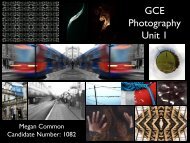GCSE Photography
Lesson Objectives and Outcomes for GCSE Photography Coursework Projects
Lesson Objectives and Outcomes for GCSE Photography Coursework Projects
You also want an ePaper? Increase the reach of your titles
YUMPU automatically turns print PDFs into web optimized ePapers that Google loves.
Keywords<br />
APERTURE<br />
ARTIFICIAL LIGHT<br />
B&W<br />
BACKGROUND<br />
BACK-LIGHTING<br />
BALANCE<br />
BRACKET or<br />
BRACKETING<br />
CLOSE-UP/MACRO<br />
COMPLEMENTARY<br />
COLOUR<br />
COMPOSITION<br />
CONTRAST<br />
CROPPING<br />
A circle-shaped opening through which light passes to strike the film. The aperture is usually<br />
created by an iris diaphragm that is adjustable, enabling the aperture to be made wider or<br />
narrower, thereby letting in more or less light. The size of the aperture is expressed as an f-<br />
number, like f/8 or f/11.<br />
Illumination that comes from a man-made source, such as electronic flash.<br />
Black and white.<br />
The part of a scene that appears to be furthest from the viewer, behind objects in the foreground.<br />
The area within the viewfinder that is behind the subject of a photograph.<br />
Light directed at the subject from behind the subject.<br />
Compositional harmony of a scene based on the placement of elements of different sizes, shapes<br />
and colours.<br />
A series of pictures, at least three, of the same subject with varying exposures - (1) the main<br />
exposure, which is presumed to be correct, but may not be; (2) a slight overexposure, (3) a<br />
slight underexposure “Bracketed” exposures fall on either side of the exposure that is<br />
presumed to be correct.<br />
Generally, a picture of a subject that fills the frame, with the subject looking particularly close to<br />
the camera. Images of tiny objects in frame-filling, larger-than-life sizes.<br />
A complementary colour is one of a pair of primary or secondary colours that are in opposition to<br />
each other on a colour wheel.<br />
Complementary Colours:<br />
Blue and orange Red and green Yellow and purple<br />
The arrangement of the elements (subject and other objects) in a scene or photograph.<br />
The range of difference between highlights and shadow areas in an image.<br />
Removal of parts of an image in order to improve the image’s composition. Cropping is<br />
sometimes also used in reference to a photographer moving closer to a subject, thereby<br />
eliminating (cropping) unnecessary surrounding elements from the composition.




